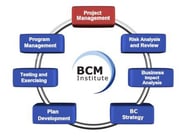Manage Project Deadlines and Milestones
Break Activities into Measurable Tasks
The BCM planning process is divided into seven individual phases. Each phase is broken down into detailed objectives, tasks, and deliverables.
To complete each key activity, specific tasks need to be assigned to individual members of the BCP project team. These tasks should be explicit, clear, and measurable.

In other words, it must be possible for the Organization BCM Coordinator to “measure” successful completion through some verifiable end product of the task. Never assume a task has been completed successfully simply because it is reported as complete.
Refer to table "Project Schedule & Elapse Time" for Typical BCP project schedule
Develop a Critical Path
Each phase of the BCP project consists of many key activities, all requiring varying amounts of time to complete. Some activities can be scheduled concurrently; others can only be scheduled consecutively. By mapping out the interdependencies of these activities, a “critical path” can be developed which identifies those activities which must be completed on time in order to remain on schedule. While all activities are ultimately critical, those on the critical path are the ones that will require the closest attention by the Organization BCM Coordinator.
Determine Key Milestones
The Organization BCM Coordinator needs to identify the key milestones and keep the Executive Management informed of them. The Executive Management needs to be kept informed on the overall project progress and must provide the Organization BCM Coordinator with an opportunity to highlight issues and “delinquent” business units that may be stalling the project.
The key is to determine critical milestones that will interest the Executive Management.
Have Formal Status Reporting
Regular and frequent status reporting against the BCP project plan is essential. Do not be afraid to challenge what is written in the reports by the business units. Often you need to read between the lines to get the real story. The key is to produce an executive summary on the status to the Executive Management periodically. This will enhance the credibility of the reporting objectives.
The major job of an Organization BCM Coordinator is not to monitor the progress but to manage. Because the real size of the BCP project cannot be known until the critical business functions are determined, the Organization BCM Coordinator has to carefully monitor the progress so that changes to the BCP project plan can be made in a timely fashion.
Ensure Accountability
Each task in the project plan must be clearly assigned to an individual and he or she must be made accountable.
A common observation is that if no one involved in the BCP project is made accountable for meeting target dates, falling behind schedule will be inevitable. This is often due to the assignment of the task to a group of personnel and not to individuals.
Resolve Delays Immediately
Typically, BCP projects fall behind schedule in small increments: a week, followed by two weeks, and so on. Suddenly, the BCP project is months behind schedule. Always make every effort to resolve delays as soon as possible. This is particularly important during the early stages of the BCP project when the perceived urgency is less. It is important to remember, however, that a week lost at the beginning of a BCP project is the same length as a week lost at the end of a BCP project.
Conduct Regular Status Meetings
Frequent meetings of the entire BCP project team may seem counterproductive. However, holding team meetings every two to three weeks to review the status of the various tasks and activities is the most effective way of ensuring that the BCP project remains on schedule. These meetings will:
- Provide an opportunity to identify and resolve problems
- Help keep the pressure on BCP team members to meet target dates
Timing of Meetings
The timing of meetings is critical, depending on the reasons you have for holding them. There are a number of factors to take into account. Consider the following:
- The time of day will dictate how much time there is for discussion
- The day of the week can affect people's level of interest
- The amount of document you distribute before the meeting will affect the depth of discussion and questioning
- The number of participants
- The participants who can influence the level of discussion and possible opposition
Meetings are a great way to receive official endorsement for your next actions. But if they are not run properly, they can also waste much time. It is a good idea to lobby the members in advance on any controversial topic so as to minimize the time spent during a meeting, and also maximize the chance of the issues being agreed upon.
Get It and Put It In Writing
There is no argument that informal discussions have their place in the BCP project process. However, if you are going to rely on any agreement reached during a discussion then you must have it in writing.
Even if you consider the discussion to be formal, as for example a prearranged meeting in someone's office, memories are often not consistent. If the outcome of your BCP project, and possibly the future of your job, depends on any agreement reached under those conditions, then you must have it in writing.
It can be as simple as a memorandum to the other person confirming what was agreed upon. It is sometimes safer to include a provision that, if no one replies to you to the contrary within say 24 hours, then the memorandum is accurate. Remember to amend the BCP project plan accordingly and refer to the memorandum.
BCM Project Management StepsClick to find out more about the detailed requirement for each step |
|||||
| Back To | 1 | 2 | 3 | 4 | 5 |
 |
 |
 |
 |
 |
 |
| 6 | 7 | 8 | 9 | 10 | 11 |
 |
 |
 |
 |
 |
 |
Reference
More Information About Blended Learning BCM-5000 [BL-B-5]
To know more about our blended learning program and when the next course is scheduled, feel free to contact our friendly course consultant colleagues via sales.ap@bcm-institute.org. They are the BL-B-3 Blended Learning BCM-300 ISO22301 BCMS Implementer and the BL-B-5 Blended Learning BCM-5000 ISO22301 BCMS Expert Implementer.










![FAQ [BL-B-3]](https://no-cache.hubspot.com/cta/default/3893111/b3824ba1-7aa1-4eb6-bef8-94f57121c5ae.png)


